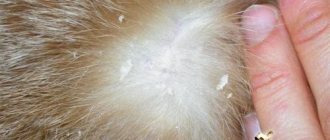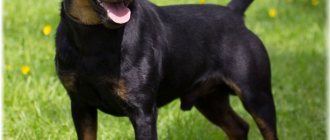Our four -legged friends have a very keen sense of smell, so their abilities are highly valued by hunters, investigators and customs officers. Their vision is no less developed, very different from human vision. Despite the similar structure of the eyes, scientists do not fully understand how exactly dogs see our world and whether their visual perception is really that good. But the available data is more than enough to be surprised by your pet’s capabilities.
Interesting anatomy: the structure of the eye and the “visual” areas of the brain
The dog eye consists of the cornea, iris, pupil, lens and retina. The very first layer performs a protective function, and the very last is responsible for transmitting images to the brain. The final picture is formed by the visual cortex, located in both hemispheres of the brain. It is concentrated in the occipital lobe.
Light waves refracted by the lens enter the retina, which consists of many photoreceptors: cones and rods. The former determine the color in which dogs see the world, and the latter are responsible for the acuity of night vision.
Structure of a dog's eyes
Vision is an ability or skill that allows you to perceive the world around you in color and volume. In addition to vision, dogs have the senses of touch, smell and hearing. You shouldn’t write off intuition, which is usually called the sixth sense. The eye is a vulnerable and unique organ, since it is the only one directly connected to the brain and the outside world at the same time.
From an anatomical point of view, the eye is divided into fragments, each of which has its own function. Vision in dogs, or more precisely, its quality directly depends on the condition of each part of the eye. That’s right, as soon as the disease affects one part of the eye, the others will also react. The age of the canine genus is unknown, but the domestication of four-legged animals (then wolves) occurred approximately 10 thousand years ago. The survival of a species directly depends on the ability to adapt, that is, to evolve. The dog family had to work doubly hard, since both its wild and domestic representatives have survived to this day. Naturally, over 10 thousand years, dogs have lost some of their abilities, but replaced them with others.
A dog's eyes are made up of three sections or layers: fibrous, vascular, and retinal. In addition, each eye is “equipped” with protective organs, lenses, clear lenses, irises, corneas and other important components. To understand the issue completely, let’s look at the structure of the eyes in a little more detail.
The fibrous membrane consists of two parts: the sclera and the cornea . The sclera is elastic and elastic, it supports the shape of the eye. The cornea is the first part of the eye that encounters light rays on its way to the optic nerve. When the cornea becomes clouded or detached, the dog loses its vision. Between these two layers there is a choroid. Blood vessels supply the outer chamber of the eye with oxygen and nutrients. Circulating blood not only brings useful substances, but also carries away decay products. When the eyes are overstrained or blood pressure is high, the blood vessels enlarge or burst; outwardly it looks like a red mesh on the white of the eye. All three layers (not each separately) have sufficient elasticity to hold the eye's lens just behind the pupil.
Next comes the visible part of the eye - the iris and pupil . This layer divides the eyes into anterior and posterior chambers. The pupil is an opening in the choroid; it has the ability to contract and expand. This process is called accommodation, and it allows you to adjust the thickness of the light beam entering the eye and the shape of the lens. In the dark, the pupil is wide, which allows you to capture the maximum volume of refracted light rays. At the same time, the lens is maximally expanded, which simplifies the penetration of light rays to the optic nerve.
The lens has an elastic structure and can shrink slightly. It is this property that allows the dog to focus its vision on objects located at different distances. It is generally accepted that the lens is the most important part of the eye. At least, it is the one that affects visual acuity the most. The lens has no receptors or nerve endings, but it is responsible for focusing vision. There is a small layer of fluid in front of the lens, and behind it is the vitreous body. These three layers are directly involved in capturing and transmitting light rays to the retina.
The retina is the layer of the eye that provides light perception or light sensitivity. The familiar rods and cones are responsible for vision in varying degrees of illumination. Dogs are versatile predators; they can hunt during the day, at dusk and at night. The number of rods and cones on their retina is approximately the same.
This is interesting! Rods and cones are called photoreceptors.
When a beam of light strikes the rods and cones, it is converted into an electromechanical impulse. There is a hole in the retina from which the optic nerve appears, and it, in turn, is connected to blood vessels. The converted signal irritates the nerve and moves to the brain. Next, the signal is converted into an impulse and the dog sees the picture. All these events happen very quickly, so much so that it is difficult to comprehend.
This is interesting! The picture the dog sees is upside down. A correct image of the world around us is the work of the brain.
Do dogs see colors? An eternal, controversial question for which there is no answer.
Until recently, it was believed that dogs only see black and white pictures. Experiments have shown that tetrapods can distinguish between some spectra of green and blue. The red spectrum is not available for dogs. There is an opinion that dogs do not see colors, since a black and white picture has greater contrast and allows them to more successfully track down potential prey. It is known that at night dogs see the world around them in gray with a blue tint.
What colors do dogs see?
It has long been assumed that dogs see the world in black and white. Actually this is not true. The color spectrum they distinguish is much wider, but still inferior to that detected by humans. The small number of cones is to blame for this.
Our pets do not perceive the red and green color spectrum, but they can clearly distinguish blue-violet and as many as 40 shades of gray. The tapetum, a reflective membrane located directly behind the retina, is responsible for this.
In terms of their vision, animals resemble colorblind people. Despite this, they easily cope with the work of a guide and accurately transfer blind people to the desired traffic light. The thing is that four-legged helpers pay attention to the location of the signal and its brightness, and not to a specific shade.
How does pet vision differ from human vision?
Do dogs distinguish colors or not and which ones?
When considering what kind of vision dogs have, it is important to highlight those features that distinguish it from humans. Despite the similar structure, some specific features stand out:
- see much less colors and shades;
- better oriented in semi-darkness;
- the panorama is wider than that of a person (by about 70%). Binocular field angle - 65-70°;
- The dog distinguishes nearby objects worse than distant moving ones.
The specificity of a dog’s perception of the world is that they see completely different colors
Differences in perception between humans and dogs
The picture we see is significantly different from how dogs perceive the world. Among the main features of canine vision are:
- Limited color perception. Because of this, the world of our four-legged friends is 3 times less colorful and a little blurry.
- Good spatial orientation after dark. Numerous cones are responsible for this, drawing clear boundaries between different shades of gray.
- A wider binocular field angle, turning the whole world into a huge panorama.
- Farsightedness. Animals see very poorly at close range and do not have a macula responsible for visual acuity. For this reason, they focus not on the object itself, but on its movement. Thanks to this feature, pets can clearly distinguish moving objects located at a distance of 1.6 km.
- Higher speed of visual perception. Our pets do not understand what is happening on TV screens. The standard frequency (60 Hz) is too low for them to see a moving picture. The image shown on the screen is perceived by them as a chaotic flickering of static frames. Therefore, the interest in watching programs together is explained more by the sounds they catch.
In addition to the tapetum, four-legged pets have one unusual organ for us - the third eyelid. Like the cornea, it has a protective function and acts in a similar way to a horizontal windshield wiper.
Is it true that dogs have poor eyesight?
Compared to humans, dogs have much poorer vision. If we had a chance to look at the world through the eyes of our pets, a rather hazy picture would appear before us. This means that not every dog can recognize its owner from a great distance, especially if he is not moving. For example, if you are standing silently on the other side of a football field, the dog will recognize you when you make some characteristic movement. Due to the large number of rods in the retina, dogs see moving objects better than stationary ones. That is why even small changes in the owner’s posture mean a lot to the pet. Dog owners should train their four-legged friends with this fact in mind. If you want your dog to perform an action based on a silent signal, you need to use a wide, sweeping arm motion. In addition, the dog's sensitivity to action largely explains why the animal sometimes gets scared when you suddenly stand up or quickly walk towards it. Your pet may interpret this as a sign of danger, especially if you have just recently welcomed your dog into the family and are just starting to get to know each other.
Why is a dog’s vision not the main way of perceiving the world?
In fact, it is not so important for the perception of the world what kind of vision a dog has. This task is perfectly accomplished by acute hearing and a developed sense of smell, many times superior to humans.
Unlike humans, who rely 90% on their eyes, animals navigate by sounds and smells. Four-legged pets even detect ultrasound, and with the onset of darkness their sensitivity only improves. At night, they easily distinguish sounds at a distance of up to 150 m, so noise inaudible to us can cause them anxiety and seemingly causeless barking.
Despite myopia, our pets never lose a piece of food that falls out of the bowl. They just find it by smell. Up to 1 million different aromas are distinguishable for a dog's nose, but only 40 thousand for a human nose. This feature is used when searching for missing things and people, since the service dog clearly senses odors within 1 km.
How dogs see people
I would like to think that a beloved dog is able to see and recognize its owner under any conditions and in any condition. This is difficult to verify under normal conditions, because the animal orients itself in space and receives information not only through vision. In the arsenal of four-legged animals there are also such tools as hearing, smell, and touch. Under experimental conditions, when the volunteer dog did not have the opportunity to use them, it turned out that it was reckless to make decisions solely on the basis of what he saw.
A dog does not immediately visually notice a stationary person, even an acquaintance.
It is rare that an owner does not flatter himself, thinking that in the eyes of a dog he looks strong and beautiful. You will have to disappoint: a person standing or sitting nearby appears to the pet as slightly blurry and not as colorful as he really is.
In the light and in the dark
Four-legged pets are excellent hunters. Nature made sure that they saw well not only in the light, but also in the dark. Their pupil regulates the amount of light passing through, contracting and dilating in different types of lighting. Next, the rays that hit the retina are processed by one of its sectors:
- Lower
. Absorbs too bright streams, facilitating visibility even in harsh light. Thanks to this, the animals do not need sunglasses. They can calmly look at the sun with wide open eyes without squinting.
- Upper
. This sector is responsible for how dogs' vision becomes at dusk. The tapetum, located behind the retina, reflects oncoming light and acts in a similar way to car headlights. It is because of this that you can see an unusual glow in the eyes at night. The specific shade depends on the color of the iris.
The clarity of the image visible to a dog's eye under night lighting is almost 4 times higher than human capabilities. A dog that finds itself in an unfamiliar dark room will have no problem finding its way around it, avoiding collisions with chaotically placed objects.
Other features of world perception
The world through the eyes of a dog is significantly different from the picture that appears before a person. This is due to the fact that people receive more than 90% of information through visual analyzers, while for predators hearing and smell are of greatest importance.
Interesting facts about how a dog sees our world:
- perceives up to 80 frames per second (for comparison, in humans this figure is 56 frames). Therefore, it is not interesting for your pet to watch TV; he does not see any dynamics. However, football often becomes a dog's favorite spectacle; players chase the ball across the field at just the speed that the dog's eye can see;
- the dog always recognizes his owner, despite the fact that he sees him completely differently than the man himself, looking in the mirror. The image of the owner in the animal’s perception is unclear and blurry;
- Predators have binocular vision; they see the world with both eyes, which helps them track prey. And in rodents and other potential “food” it is monocular, with a wide viewing angle. This is a natural defense of nature, which helps to notice a sneaking “hunter”.
Dogs' vision is different from humans in many ways.
How far and how wide can dogs see?
Due to the absence of a yellow spot, animals practically do not see objects located at a distance of up to 25 cm. But they perfectly distinguish between stationary objects within 600 m and moving ones within 900 m. This feature is determined by the hunting instinct, where it is important not to miss the fleeing prey. This is why you should not run away from an unfamiliar dog.
In addition to the dog’s range of vision, its field, that is, latitude, is also unique. While a human's viewing angle is limited to 180°, a dog's is as much as 250°. Thanks to this feature, animals see what is happening not only in front, but also on the sides, skillfully assessing the distance to objects located in the visual zone.
Range and breadth of vision
In the retina, in addition to rods and cones, there are receptors that perceive the movement of objects, the appearance/disappearance of light signals and other phenomena. The eyes of these animals only perceive information, and the brain is responsible for processing it and forming a single picture, which analyzes the data coming from the eyes (both eyes look independently of each other, and then the image is combined). Dogs and humans are characterized by binocular vision, when the picture is formed on the basis of partially duplicated information coming from both eyes. Thanks to this, the ability to distinguish relief, look into depth and assess how far an object is from the eyes appears.
But unlike the human eye, the dog's eye lacks a central fovea with cones, which provides maximum visual acuity. Due to this, the animal sees equally well over the entire surface of the retina. Through his eyes, a panoramic picture of the world is obtained, so he does not need to quickly move his eyes after a moving object.
The absence of this fossa also explains the lower visual acuity of pets. This is especially true for near objects that are closer than 30 cm from the eyes and look blurry. But at this distance, the sense of smell works well, so even a blurry image can be recognized, whether it is a bowl of food or the owner’s own face.
Dogs see medium-sized objects at a distance of 100-150 meters. However, this distance is not so important, since they, like other predators, react more to movement, including facial expressions and gestures of the trainer.
For comparison: a dog can distinguish a running person at a distance of up to 400 m (and even up to 800 m after special training). If a person does not move, the animal may not notice him even at a 100-meter distance until he smells it.
Particular attention should be paid to dogs' peripheral vision. Their visual angle is generally wider (250 degrees) than that of humans (180 degrees), while their area of best visibility is narrower. This is also explained by the peculiarities of evolutionary development: a predator needs to look straight ahead and concentrate on the prey, but at the same time not lose sight of the surrounding environment.
Features of viewing breadth also depend on the breed and body structure: individuals with a wide muzzle and a small nose have a smaller viewing angle compared to representatives of hunting breeds.
Clarity, Sharpness, Contrast
Having figured out what kind of vision dogs have, it is easy to understand that the clarity, sharpness and contrast of the image they perceive is significantly inferior to humans. For our pets, the world around us looks blurry and faded. It can be compared to a photograph of very poor quality. But there are also some peculiarities.
Picture quality improves when focusing on dynamic objects. If you freeze when confronted with an aggressive animal, you will become practically invisible to it. Although you should not completely rely on this trick, since your presence will be confirmed by a keen sense of smell.
An example is checking visual acuity using a special table. A person with perfect vision will see the first 10 lines, but his four-legged pet will only see the first 3.
Definition
According to this indicator, dogs are inferior to people; they see the world blurry and unclear. Small objects merge before their eyes into amorphous spots, painted in different tones. At the same time, dynamic objects are perceived by animals much more clearly than stationary ones.
Note! The movement of an object helps dogs navigate. Therefore, when an animal is aggressive, you can freeze, since a static object is practically invisible to it.
Hypothetically, when checking acuity on an ophthalmic chart, the dog would only be able to see the third line.
For dogs there are no red and green tones, they merge into gray tones
Do some breeds see differently?
Despite the general similarity of visual perception, some breeds see the world a little differently. What kind of vision your dog has can be determined by the shape of its skull and nose, as well as the distance between the eyes.
Greyhounds and hounds, intended for hunting, have a greater angle of latitude than representatives of brachycephalic breeds (pugs, bulldogs, Pekingese). Despite this, flat-faced pets are no less amazing. They see the image on the TV screen and the image of their owner much more clearly. That is why such animals are more affectionate and emotional.
Features of the visual organs of some breeds
In general, dogs are predators, so in general terms the specifics of their visual perception of the world are the same, regardless of breed. Although some features are still revealed. The ability to perceive a panoramic picture of the surrounding world is inherent in all breeds. But dogs with a long nose and narrowed muzzle have a greater degree of visual latitude.
Representatives of some breeds have a short nose and a wide skull. This is why they have very poor peripheral vision. We are talking about:
- pugs;
- Pekingese;
- bulldogs.
For your information! Some researchers believe that the vision of wild animals is sharper than that of domestic pets. Evidence has not yet been received, but statistics show that all inhabitants of the wild have more developed senses than those tamed by people.
Vision problems
With age, visual function weakens - and this is absolutely normal, but sometimes problems appear at a very young age. For this reason, you should know exactly what kind of vision your dog has and how much it differs from the recommended norm.
In addition to a full examination at the veterinary clinic, there are several simple ways to assess eye health at home:
- Checking pupil reaction
. Move your hand in front of your pet. If he is healthy, then his pupils will move along a similar route.
- Creating an "obstacle course"
. Place various objects around the room in a chaotic order, go to the farthest corner and call your pet. A healthy dog can easily navigate the route without hitting any obstacles.
- "Cotton Ball"
. Roll small balls of cotton wool and throw them in front of the animal. His pupils must watch the fall without interruption. It is recommended to perform this exercise in pairs with an assistant who will cover one of the eyes. In this case, you can evaluate the health of each eye separately.
In most cases, ophthalmological pathologies are to blame for the deterioration of visual function. Knowing the main reasons for their appearance, you can easily maintain the health of your pet.
Why they occur and how to prevent them
Eye diseases occur due to mechanical injuries and neoplasms, as well as as a complication of allergies and infections. Violations can be prevented by strengthening the immune system and eliminating provoking factors. To do this you need:
- Monitor the quality and balance of your diet.
- Promptly trim excessively long hair on the face that irritates the cornea.
- Regularly treat your eyes with herbal infusions and protect them from drying out.
- Place all dangerous objects out of reach.
- Check the integrity and cleanliness of the space between the skin folds after each walk.
- Don't skip your annual checkup with your veterinarian. It is recommended to pay special attention to breeds with bulging eyes.
Sometimes genes are to blame for a disease. In this case, it is they who determine what kind of vision the dog will have. Congenital pathologies cannot be treated, but their development can be slowed down.
Life of a blind dog
Dog blindness is less dangerous than human blindness. With proper care, a blind animal will be no less healthy than its sighted counterparts. This is explained by the maximum aggravation of the remaining sense organs.
You will have to talk more with a blind pet, avoiding sharp sounds and sudden touches. Before stroking, you should approach him or give him a hand so that he can hear you approaching or smell a familiar smell.
It is recommended to keep all objects in the house in their original places, since any rearrangement can cause prolonged disorientation. When walking, you should use a leash or a special “cane”, consisting of a vest and a built-in half-ring. Thanks to this device, the animal will be able to “feel” surrounding objects without colliding with them directly.
Conclusion
Be sure to monitor your dog's vision to avoid premature blindness. With regular checkups and following basic recommendations, you can keep your pet healthy for many years.
The article is for informational purposes only. Contact your veterinarian!
Dog vision test
Just like in humans, dogs' vision can deteriorate due to old age, injury, or various diseases. For example, in some animals, significant problems (even complete blindness) arise due to plague. At the same time, often - again, as in people - such problems do not affect the way the eyes look. Then how do you know if your pet can see well?
There are several simple methods for determining a dog’s vision that every owner can try. First of all, pay attention to the behavior of the animal: a dog with normal vision can freely navigate the surrounding space and does not bump into walls, corners or other obstacles. If your pet has problems getting through a door or around an unexpected obstacle on the road, there is a high probability that his eyesight is failing him.
To test whether a dog can see, place your hand near his eyes without touching his eyelashes and observe his reaction. If it does not follow, and the pupils do not react to light (do not dilate when you block the light with your hand, and do not narrow when you remove it), then the animal definitely has serious vision problems.
Another test method: tie the dog and move away from it at a distance of 10-15 meters. Then call her and make a few familiar gestures or throw a fetch object. A dog with good vision will react accordingly, but a dog with poor vision will not show any reaction.
Remember to always consult your veterinarian if you have any questions, suspicions or concerns.
And a few more interesting facts
- Dogs are not able to recognize themselves in reflections, since vision for them is not the main source of information. They rely more on hearing and smell. And the reflection in the mirror does not smell or make noise - so why pay attention to it?
- Our four-legged friends cannot focus their vision on nearby objects. The distance from the pet's eye to the thing must be at least 30 cm so that he can clearly see the object being shown to him. For a person, only a few centimeters are enough for this.
- Dogs see moving objects better than stationary ones. They are able to notice a moving object at a distance of up to 900 m, but a stationary one - only up to 600.
- Dogs do not watch TV shows, since the frame rate of the TV is only 50-60 hertz, while the pet needs 80 hertz. And therefore, instead of a movie, they see continuous flickering, and they become not interested in watching it. The photo clearly shows that the bulldog is not interested in what is happening on the screen.
- Dogs are better at determining the distance to an object. The rods located near the center of the eye allow them to do this (they are located exactly where the light rays are not distorted). If you remember geometry, you can understand how your pet’s brain calculates the distance to an object of interest to the animal. The vertices of the triangle are the dog’s eyes and the target.
- The reflective membrane for dogs can be of different colors. Pets with a dark iris will have a darker iris than light-eyed animals. The color of that very night “glow” of the eyes depends precisely on the shade of the membrane - yellow-green or green. Loading …










